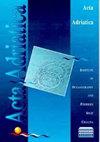Histological structure and histochemical composition of the digestive tract of salema porgy, Sarpa salpa (Linnaeus, 1758) (Teleostei: Sparidae)
IF 0.6
4区 生物学
Q3 MARINE & FRESHWATER BIOLOGY
引用次数: 0
Abstract
The histological structure and histochemical characteristics of the digestive tract of five specimens of salema porgy (Sarpa salpa, L.) were analysed using haematoxylin-eosin, Alcian blue/PAS and orcein-Giemsa staining techniques. The digestive system of salema porgy consists of esophagus, stomach and intestines with associated organs such as liver, pancreas and gallbladder. The wall of esophagus, stomach, intestines and gallbladder has four distinctive layers: the mucosa, the submucosa, the muscular and outer layer, serosa or adventitia. The mucosa consists of two different layers: epithelium and lamina propria. Mucosa of the upper part of the digestive system is layered by single squamous epithelium, while those of lower part of the digestive system is layered by single columnar epithelium. The submucosa is a layer made of connective tissue and blood vessels. In most parts of the digestive system the muscular layer consists of two parts: circular and longitudinal. The exception is the muscular layer of the stomach fundus which has three layers: inner, medium and outer. The outermost layer in the esophagus is adventitia made of connective tissue, blood vessels and nerves. In the stomach, intestines and the gallbladder this layer is replaced by serosa. Histochemical analysis has shown that mucosal cells in all parts of the digestive tube contain acid mucopolysaccharides (MPS). The liver consists of hepatocytes separated by sinusoidal capillaries. The pancreatic tissue is scattered along the liver parenchyma and along the wall of pyloric caeca. The present study is the first record on digestive system histology of salema porgy showing that it is congruent to its feeding habits.salema porgy, Sarpa salpa (Linnaeus, 1758)消化道的组织结构和组织化学组成(Teleostei: Sparidae)
采用苏木精-伊红、阿尔西安蓝/PAS和orcein-Giemsa染色技术,分析了5株萨尔帕猪(Sarpa salpa,L.)消化道的组织结构和组织化学特征。salema porgy的消化系统由食道、胃和肠以及肝脏、胰腺和胆囊等相关器官组成。食道、胃、肠和胆囊的壁有四个不同的层:粘膜、粘膜下层、肌肉和外层、浆膜或外膜。粘膜由两个不同的层组成:上皮层和固有层。消化系统上部的粘膜由单个鳞状上皮分层,而消化系统下部的粘膜由单层柱状上皮分层。黏膜下层是由结缔组织和血管组成的一层。在消化系统的大部分部位,肌肉层由两部分组成:圆形和纵向。胃底肌层是个例外,它有三层:内层、中层和外层。食道的最外层是由结缔组织、血管和神经组成的外膜。在胃、肠和胆囊中,这一层被浆膜所取代。组织化学分析表明,消化管各部位的粘膜细胞均含有酸性粘多糖(MPS)。肝脏由肝细胞组成,肝细胞由正弦毛细血管分隔。胰腺组织沿着肝实质和幽门盲肠壁散布。本研究首次记录了salema porgy的消化系统组织学,表明其与食性一致。
本文章由计算机程序翻译,如有差异,请以英文原文为准。
求助全文
约1分钟内获得全文
求助全文
来源期刊

Acta Adriatica
生物-海洋与淡水生物学
CiteScore
1.60
自引率
11.10%
发文量
13
审稿时长
>12 weeks
期刊介绍:
Journal "Acta Adriatica" is an Open Access journal. Users are allowed to read, download, copy, redistribute, print, search and link to material, and alter, transform, or build upon the material, or use them for any other lawful purpose as long as they attribute the source in an appropriate manner according to the CC BY licence.
 求助内容:
求助内容: 应助结果提醒方式:
应助结果提醒方式:


